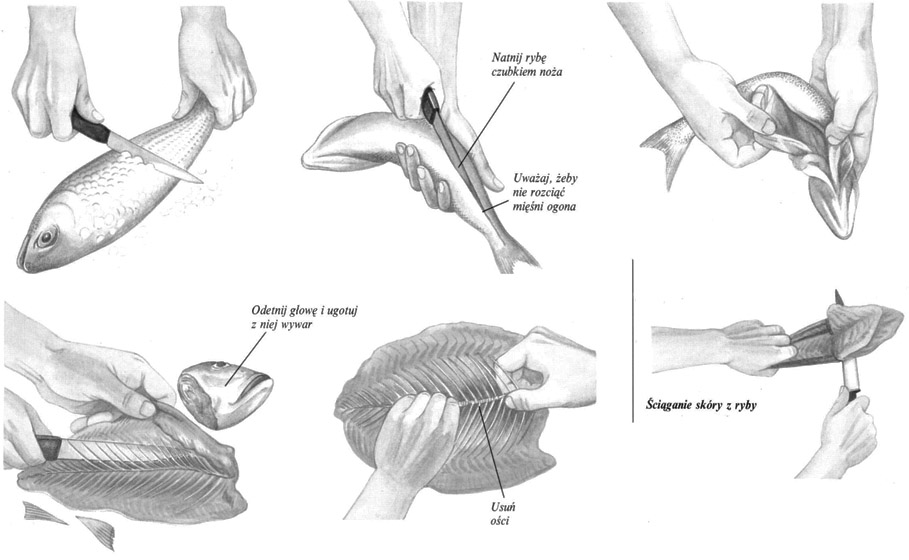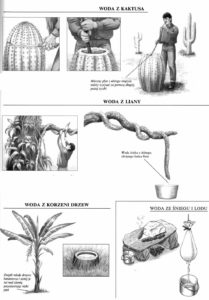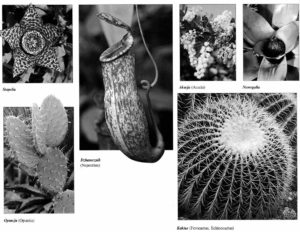Części podziemne niektórych roślin – korzenie (zwłaszcza spichrzowe), kłącza, bulwy lub cebulki są bogate w witaminy oraz inne składniki odżywcze, jak skrobia i dlatego mogą stanowić cenne źródło naturalnego pożywienia. Jedzenie surowych bulw, cebulek lub korzeni wielu roślin jadalnych może powodować różne dolegliwości, dlatego bezpieczniej ugotować je zawsze przed pożyciem. Korzonki należy oskrobać, a potem ugotować, po czym można je upiec. Skórka wielu korzeni zawiera dużo witamin. Dlatego, o ile tylko da się ją zjeść, nie należy obierać korzenia zbyt dokładnie. Są jednak korzenie, takie jak na przykład żywokostu, które koniecznie trzeba obierać, żeby usunąć szkodliwe substancje zawarte w skórce i bezpośrednio pod nią.
Aby móc stwierdzić, czy dany korzeń lub cebulka nadaje się do zjedzenia, trzeba rozpoznać roślinę, z której wyrasta. Rośliny spotykane w różnych regionach wyglądają często podobnie. Dlatego nigdy nie wyrokuj jedynie na podstawie wyglądu korzenia, cebulki bądź bulwy o tym, czy są jadalne. Wystarczy powiedzieć, że cebulka śmiertelnie trującego zygadenusa bardzo przypomina zwykłą, tak dobrze nam znaną cebulę. Większość cebulek, korzeni lub bulw roślin jadalnych trzeba długo gotować przed zjedzeniem.
ROŚLINY O JADALNYCH KORZENIACH
Lilie wodne, inaczej grzybienie (Nymphaea). Różne gatunki lilii wodnych występują w strefie podzwrotnikowej i umiarkowanej niemal na całym świecie. Nasiona, kłącza i łodygi niektórych lilii wodnych są jadalne. Część z nich ma właściwości lecznicze, jedzona więc w sposób niekontrolowany może okazać się trująca. Lilie wodne mają duże kwiaty różnej barwy i pływające, tarczowate liście.
Salsefia (Tragopogon).
Roślina z rodzaju kozibród, rozpowszechniona w Eurazji i północnej Afryce. Rośnie na terenach suchych w obszarze śródziemnomorskim. Zwykle osiąga 60-90 cm wysokości. Jej podłużne liście oraz korzeń spichrzowy są jadalne.
Kotewka (Trapa)
Ta roślina żyje w słodkowodnych akwenach w całej Europie i Azji. Jadalne są również jej twarde nasiona – na surowo lub pieczone.
Strzałka wodna (Sagittaria)
Występuje w płytkich wodach śródlądowych. Osiąga metr wysokości; liście trójkątnie strzałkowate, kwiaty małe, o trzech płatkach. Jej kłącza nadają się do jedzenia nawet na surowo, ale lepiej smakują po ugotowaniu.
Tatairak (Acorus)
Może osiągać wysokość 1,3 m. Spotykany jest w przybrzeżnej strefie wód słodkowodnych, zwykle stojących. Kłącze tataraku wydzielające olejki eteryczne nadaje się do jedzenia. Przed spożyciem trzeba go posiekać na plasterki i gotować tak długo, aż zrobi się syrop.
Orzech ziemny (Arachis)
Nasiona, czyli orzeszki ziemne nie są wcale prawdziwymi orzechami, lecz dojrzewającymi pod ziemią strąkami, przytwierdzonymi do łodygi. Sama roślina jest mala i krzaczasta, ma pierzaste liście i żółte kwiaty.
INNE ROŚLINY
Mniszek, zwany popularnie mleczem (Taraxacum), ma jadalne korzenie. Z jego prażonych korzeni, podobnie jak cibory (Cyperus) oraz kilku innych roślin, można przygotować napar będący substytutem kawy. Kłącza lub korzenie innych roślin, takich jak czermień błotna (Calla), można trzeć na drobny proszek i użyć jak mąkę. Na surowo lub gotowane można jeść kłącza słonecznika dziko rosnącego w Ameryce Północnej.



.jpg)


Wymieniony wyżej słonecznik dziko rosnący w Ameryce Północnej to zapewne Topinambur inaczej słonecznik bulwiasty. Częścią jadalną rośliny są podziemne bulwy a nie kłącza. Bulwy są bardzo smaczne i sycące, można je piec, gotować i spożywać na surowo. Topinambur jest przysmakiem dla dzików dlatego w polskich lasach jest sadzony w dużych ilośćiach